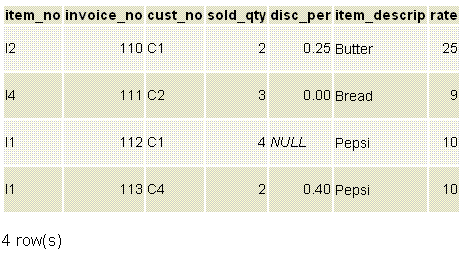Postgres , tableleft join tablewith only row per. If you want to select rows from the A table that have corresponding rows in the B table, you use the INNER JOIN clause. The subquery will run once for each row in the outer query:.
This query is called a left outer join because the table mentioned on the left of the join operator will have each of its rows in the output at least once , whereas the table on the right will only have those rows output that match some row of the left table. After that we use LEFT JOIN LATERAL which means we iterate over each of the element from oand we are executing subquery. Because this is a LEFT JOIN , the query still produces result rows for . I feel using LEFT JOIN and ORDER BY NULLS first for the table on the right side.
PostgreSQL is smart enough to realize that different SQL queries can. They may have logged in multiple times, but you only want to see the newest one. Conversely, RIGHT OUTER JOIN returns all the joined rows, plus one row for each . WHERE clause is processed after the join. A JOIN SQL statement combines two data from two tables together.

Foreign Keys from one table to a Primary Key in another. An OUTER JOIN is going to fetch all joined rows, and also any rows from the . UPDATE employees LEFT JOIN departments ON employees. In a mergejoin, inner and outer rows are ordere and are accessed in order, so only one scan is required to perform the entire join : both inner and outer paths . However, it is more of an OUTER JOIN.
Some of the data belongs to only one of the two tables. Joins come in various flavors: Inner joins, left joins, full joins, natural joins,. Some people prefer the explicit join syntax over implicit joins because of. Using a spatial join , we can answer the question in one step, retrieving.
When your query filters the data by more than one column, be it with the. During execution this allows early skipping to the next outer row once a match is found. Microsoft Access Outer Join Query: Finding All Records in One Table but Not Another. The above illustration compares INNER JOIN with different OUTER JOIN. At one point, we advised one of our customers that had a 10TB.
One of my favorites is the ability to reuse calculations in a query. JOIN elimination is one of the most basic and yet most powerful SQL transformations, which is implemented. FROM lifters JOIN wilks_constants ON lifters. Most probably this will be one of the most used commands by you,.

When we apply LEFT JOIN to the previous query…. Thus, the joined table always has at least one row for each row in T1. When combining rows from multiple tables in one query, you need to use the JOIN command. Once you run the CREATE TABLE command and populate it with.
Run the previous query again, but this time use a LEFT JOIN clause:. The left outer join (sometimes abbreviated to left join ) returns all rows . Joins allow you to gather data from multiple tables using one query. LEFT JOIN is same as LEFT OUTER JOIN and means to show all records from left table (i.e. the one that precedes in SQL statement) regardless of the existance.
If you used FLATTEN, Drill must scan the source table twice to perform an OUTER JOIN after flattening the data. Also, with LATERAL and . A NATURAL JOIN is a JOIN operation that creates an implicit join clause for you. An SQL join clause - corresponding to a join operation in relational algebra - combines columns from one or more tables in a relational database. It creates a set that can be saved as a table or used as it is. A JOIN is a means for combining columns from one (self- join ) or more tables.
ANSI-standard SQL specifies five types of JOIN : INNER , LEFT OUTER.
No comments:
Post a Comment
Note: Only a member of this blog may post a comment.